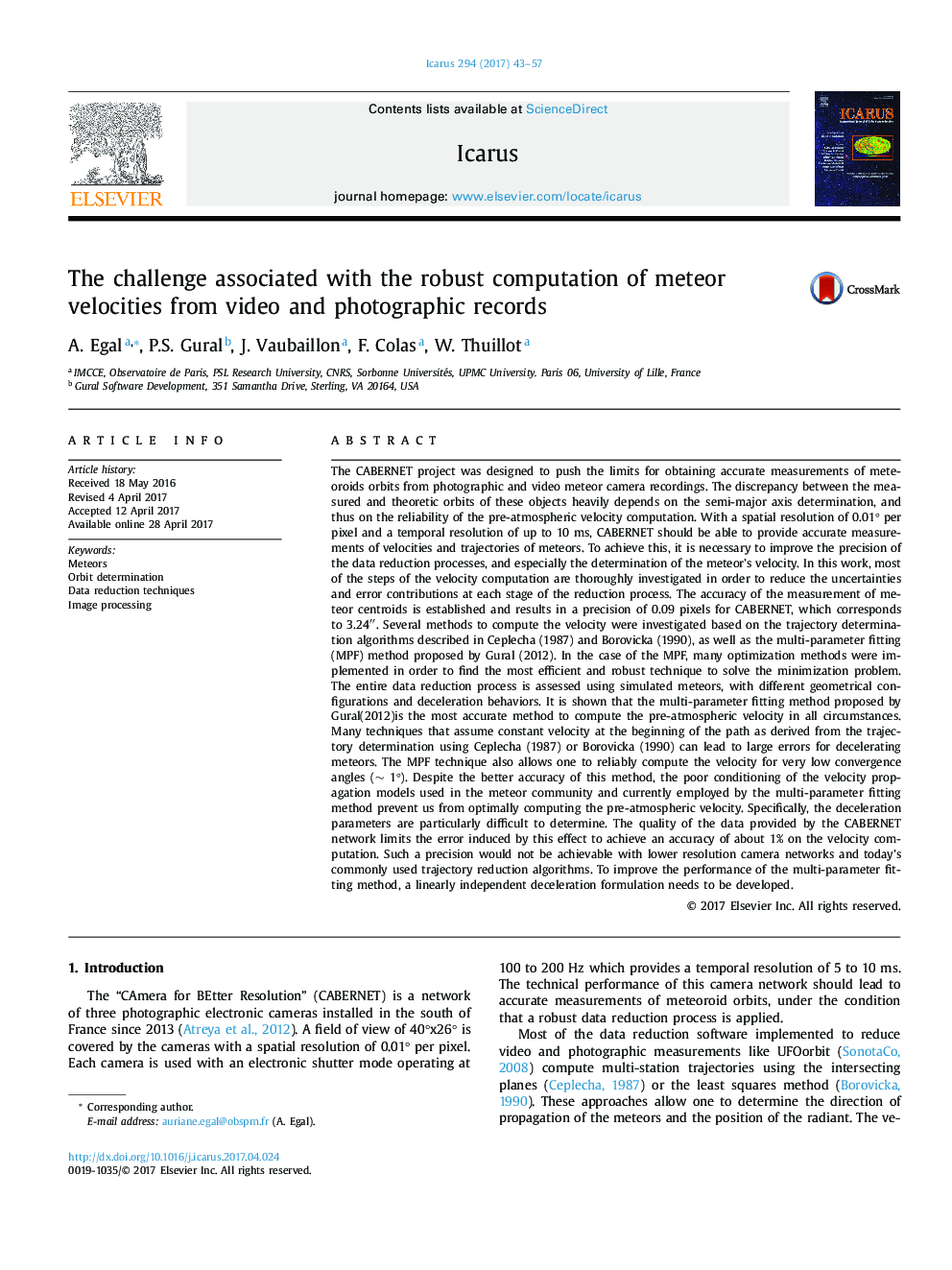| کد مقاله | کد نشریه | سال انتشار | مقاله انگلیسی | نسخه تمام متن |
|---|---|---|---|---|
| 5487380 | 1523497 | 2017 | 15 صفحه PDF | دانلود رایگان |
عنوان انگلیسی مقاله ISI
The challenge associated with the robust computation of meteor velocities from video and photographic records
ترجمه فارسی عنوان
چالش همراه با محاسبه دقیق سرعت شهاب سنگ از سوابق تصویری و عکس
دانلود مقاله + سفارش ترجمه
دانلود مقاله ISI انگلیسی
رایگان برای ایرانیان
کلمات کلیدی
شهاب سنگها، تعیین مدار، تکنیک های کاهش داده، پردازش تصویر،
موضوعات مرتبط
مهندسی و علوم پایه
علوم زمین و سیارات
علوم فضا و نجوم
چکیده انگلیسی
The CABERNET project was designed to push the limits for obtaining accurate measurements of meteoroids orbits from photographic and video meteor camera recordings. The discrepancy between the measured and theoretic orbits of these objects heavily depends on the semi-major axis determination, and thus on the reliability of the pre-atmospheric velocity computation. With a spatial resolution of 0.01° per pixel and a temporal resolution of up to 10 ms, CABERNET should be able to provide accurate measurements of velocities and trajectories of meteors. To achieve this, it is necessary to improve the precision of the data reduction processes, and especially the determination of the meteor's velocity. In this work, most of the steps of the velocity computation are thoroughly investigated in order to reduce the uncertainties and error contributions at each stage of the reduction process. The accuracy of the measurement of meteor centroids is established and results in a precision of 0.09 pixels for CABERNET, which corresponds to 3.24â²â². Several methods to compute the velocity were investigated based on the trajectory determination algorithms described in Ceplecha (1987) and Borovicka (1990), as well as the multi-parameter fitting (MPF) method proposed by Gural (2012). In the case of the MPF, many optimization methods were implemented in order to find the most efficient and robust technique to solve the minimization problem. The entire data reduction process is assessed using simulated meteors, with different geometrical configurations and deceleration behaviors. It is shown that the multi-parameter fitting method proposed by Gural(2012)is the most accurate method to compute the pre-atmospheric velocity in all circumstances. Many techniques that assume constant velocity at the beginning of the path as derived from the trajectory determination using Ceplecha (1987) or Borovicka (1990) can lead to large errors for decelerating meteors. The MPF technique also allows one to reliably compute the velocity for very low convergence angles (â¼ 1°). Despite the better accuracy of this method, the poor conditioning of the velocity propagation models used in the meteor community and currently employed by the multi-parameter fitting method prevent us from optimally computing the pre-atmospheric velocity. Specifically, the deceleration parameters are particularly difficult to determine. The quality of the data provided by the CABERNET network limits the error induced by this effect to achieve an accuracy of about 1% on the velocity computation. Such a precision would not be achievable with lower resolution camera networks and today's commonly used trajectory reduction algorithms. To improve the performance of the multi-parameter fitting method, a linearly independent deceleration formulation needs to be developed.
ناشر
Database: Elsevier - ScienceDirect (ساینس دایرکت)
Journal: Icarus - Volume 294, 15 September 2017, Pages 43-57
Journal: Icarus - Volume 294, 15 September 2017, Pages 43-57
نویسندگان
A. Egal, P.S. Gural, J. Vaubaillon, F. Colas, W. Thuillot,
